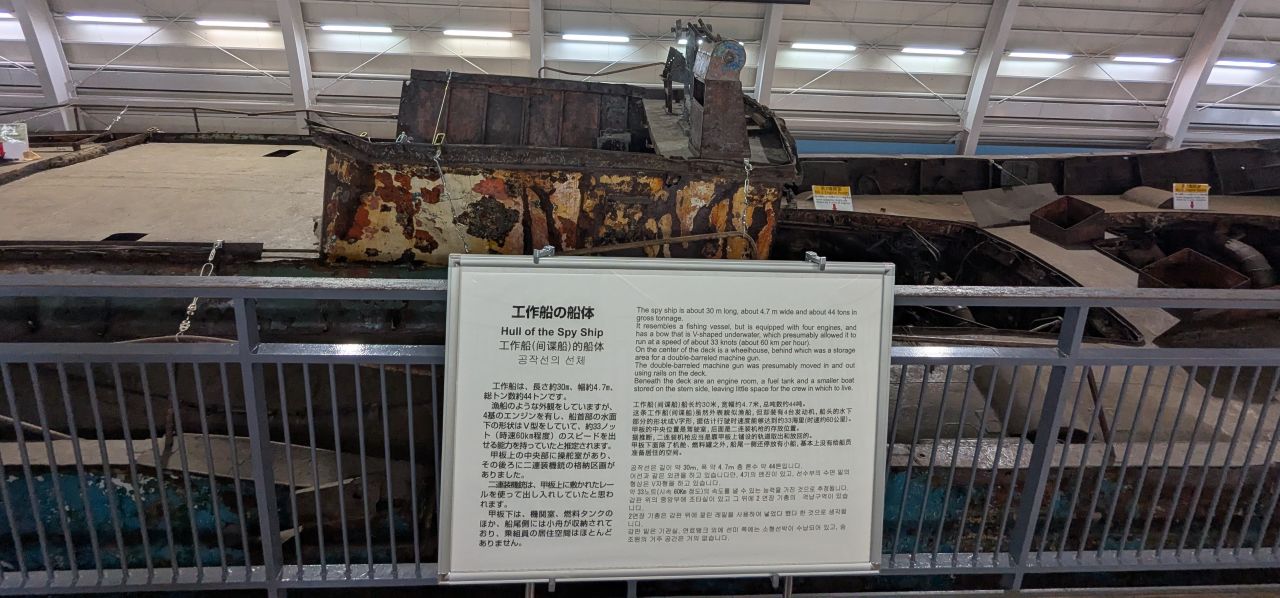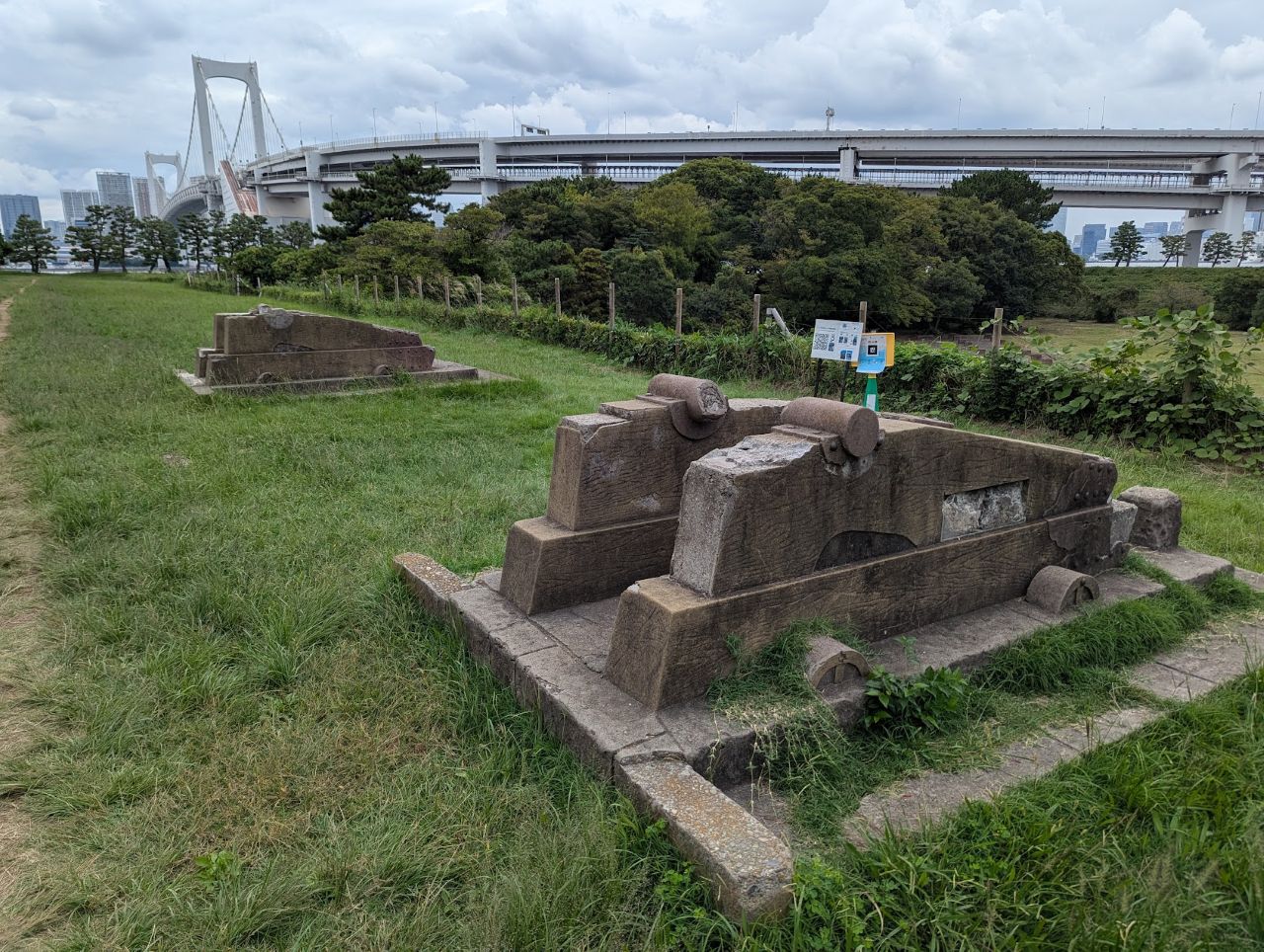Reader Albert Liu has recently been to Japan, and has kindly contributed reviews of two places he visited.
Japan Coast Guard Museum

A North Korean spy ship1
While the museum is officially titled "Japan Coast Guard Museum Yokohama", it is the subtitle "North Korea Spy Ship Exhibit" that really gives away the museum's topic: the 2001 Battle of Amami-Ōshima (English Wikipedia, Japanese Wikipedia) in which the spy ship was sunk. The entire museum consists of one counter-clockwise loop around the 30 metre-long spy ship "Changyu 1305". This is both the worst and the best thing about the museum: on one hand, the collection is not particularly large, but on the other hand, the collection that it *does* have is excellent and coherent. Most signs have English (and Korean) translations, which are serviceable overall, though a few signs are in Japanese only and occasionally some nuances seem lost in translation. Admission is free.
Sequence of events

Traveling down the starboard side, we first get an overview of the JCG's mission, other DPRK spy ship incidents, and a timeline of this spy ship incident and subsequent recovery of the vessel. The documentary on YouTube has footage from the incident and more details overall, though the museum too has its share of exclusive details, and of course the actual artifacts. A summary:
On 22 December 2001, aircraft and four ships of the JCG (PM-95 Amami, PS-03 Inasa, PS-04 Kirishima, PS-11 Mizuki) were sent to investigate a spy ship southwest of Kyūshū. They ordered the spy ship to stop, at which the spy ship attempted to flee. Since the order to stop was given within Japan's exclusive economic zone, the JCG asserted the right of hot pursuit past the Japan-China EEZ border. A nine-hour chase ensued, including a series of progressively intensifying warning shots, a fire aboard the spy ship, and multiple attempts to pincer and corral the spy ship. Finally, the spy ship opened fire on the JCG. After a brief firefight in which three were wounded aboard the Amami, the spy ship exploded (thought to be an intentional scuttling) and sank with all hands in 90 metres of water.
The JCG conducted a search, and after reaching an agreement with China, recovered the wreck, eventually unloading the spy ship at Kagoshima on 6 October 2002. After being displayed to the public in Kagoshima and Tokyo, the spy ship was moved to a permanent home in Yokohama. Its preservation was aided by donations totaling 105 million yen. The museum was opened on 10 December 2004, just under three years after the incident.
Weapons and other artifacts

Continuing towards the stern are various artifacts recovered with the spy ship. Naturally, the most eye-catching is the collection of weapons. A B-10 85 mm recoilless gun could be mounted on the bow, and a ZPU-2 twin-barreled 14.5 mm machine gun was kept hidden in a deckhouse and could be deployed to the afterdeck on a pair of rails. Along with these are various lighter weapons, including an Igla surface-to-air missile launcher, a PK light machine gun, a couple RPG-7s, and several AKS-74 rifles. (For comparison, the JCG ships were armed with Vulcan 20 mm rotary autocannons, downrated to ~500 RPM for surface use; not part of this museum.)
Other items include fake nameplates used to disguise the spy ship, a self-destruct switch, a diesel engine nameplate (made in Russia), several electronic devices (made in Japan), and various victuals.
Daughter craft

Aft of the spy ship is a speedboat, 11.21 metres long, which was stored within the hull of the mothership and could be deployed via a pair of pneumatically-powered doors at the stern. There is also a pontoon raft, an underwater scooter resembling a rideable torpedo, and various pieces of diving gear. All-in-all, a real nesting doll of a craft; other readers have described this as something out of a James Bond movie.
Top view

The port side of the ship brings us onto a raised platform, allowing us a top view of the spy ship, including the wheelhouse and engines. After a small gift shop and some informational posters about the JCG, the museum concludes with a half-scale replica of the Amani's battle-damaged bridge (according to the documentary, the original bridge is displayed in Hiroshima) as well as several pieces of equipment that had been hit by bullets.
Visiting Yokohama
As much I liked the museum, it's just not big enough to justify visiting Yokohama on its strength alone. Fortunately, there's plenty to see in Yokohama in addition to the spy ship, such as the sail training ship Nippon Maru and the foreign quarter of one of the first treaty ports. Furthermore, Yokohama is right on the path between Tokyo and Yokosuka, the latter being the home to the JMSDF headquaters and naval base, a USN naval base, and the Mikasa.
Daiba Park

With several hours to kill before my flight out of Japan, I decided to visit Odaiba, an artificial island in Tokyo Bay. In the backyard of several shopping malls, I noticed a curious fortification on the other side of a cove. This turned out to be Daiba ("Battery") Park, an almost-island connected by a land bridge to the rest of Odaiba. It's about a kilometer walk from the nearest rail station, though you can get closer by bus. Another option is to walk across the Rainbow Bridge Promenade.

Odaiba as a whole was originally constructed in the aftermath of Commodore Perry's 1853 expedition in case hostilities commenced upon Perry's return. Six battery islands were completed, with a seventh battery unfinished, and four more planned but never started. No. 3 battery was designated a national historic site on 20 December 1926 and refurbished as Daiba Park, opening on 7 July 1928. The only other battery island remaining as a distinct entity today is No. 6, which is about half a kilometer (center-to-center) to the west of Daiba Park. Inaccessible to visitors, No. 6 now functions as a bird preserve. Meanwhile, the surrounding parts of Tokyo Bay have seen massive land reclamation with numerous well-populated artificial islands.
Daiba Park is grassy and just this side of overgrown, and there are not very many discrete artifacts left. Two cannon mounts (sans the actual cannons) are all that remain of the battery proper. Inside the works there are some (fenced-off) entrances to the magazines, a stone stove, and various other low ruins. History aside, the island has great views of the inner part of Tokyo Bay. On a Monday afternoon I think I only saw two or three other people there, one of whom was a groundskeeper. It is pleasant -- though a bit uncanny -- being in such a quiet, unpopulated, antiquated scene in the middle of the planet's most populous metropolis and its countless feats of modern architecture and engineering. I wouldn't go out of my way just to see Daiba Park, but I'm glad I visited as part of the area as a whole.
1 Photos courtesy of Albert Liu. ⇑

Recent Comments